I wasn't planning to do a WIP on this build, but I thought it might be fun to do a shorter post for this one. I found this paint scheme one day when I was looking at some of my references and then I was able to find the decals for the plane, so off we go. I was basically planning to use the model as a canvas for the paint scheme, so I wanted to build a kit straight out of the box. I figured the best kit for this would be the Me-109E-3 from Tamiya. With the decals and kit in hand, I started the build.
-
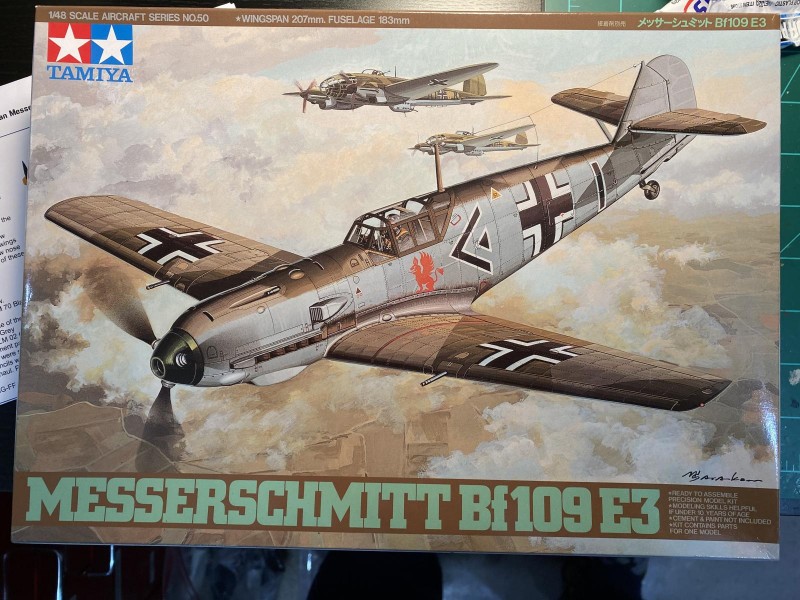
Planning for this paint scheme would be interesting. It is dark green, but was painted over Luftwaffe camouflage that was visible under the paint on the wings. The nose is yellow, as well as bands on the rear fuselage and wings. I like to use white primer as a base under colors like yellow and red so that the colors remain bright, so I planned to start with a partial thin coat of white. The rudder has 3 broad stripes of yellow, blue and red Romanian colors that need to be painted, so it will need the white primer also.
-
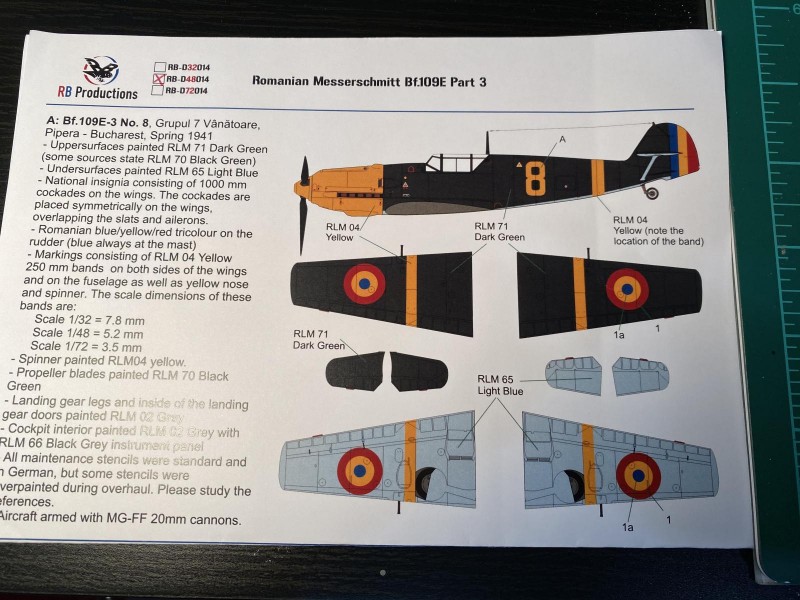
1. I was wondering why they made the point that the insignia was symmetric, till I found two of the planes that weren't.
The nose of the model consists of 2 pieces that make up the upper and lower nose panels that are glued to the kit sub-structure, and I noticed that the back end of these two pieces is exactly at the demarcation line for the yellow on the nose. After a little dry-fitting, it looks like I can paint these pieces off of the model and save a ton of masking. The rudder is also a separate piece, so the painting of the Romanian colors can also be done off the plane.
The last thing I am trying is on the two under-wing radiators. They both have some radiator screens inside the radiator structure that will be hard to get to once they are glued on the plane. Both of these radiators fit perfectly in their slots, so I am hoping to leave them off, paint the outside structure and radiator grills separately, then add them to the plane. I figure these late build add-ons will either look great, or not so much.
The first part of the build went perfectly. The instrument panel had some really good representation of the various dials and gauges, and I decided to use the kit decal for the instrument faces and detail. I was worried that the decal wouldn't settle into the relief on the panel, so I used some really strong decal set called Solvaset. This is a product that is normally used by model railroaders. I almost never use it on airplane decals because it is very aggressive. I have actually had it dissolve some decals, but I thought the Tamiya decals would be fine. A couple of applications of the Solvaset settled the decal over the relief on the panel. After adding some drops of color on the panel, I moved on to the rest of the cockpit. I built the cockpit according to kit instructions.
-
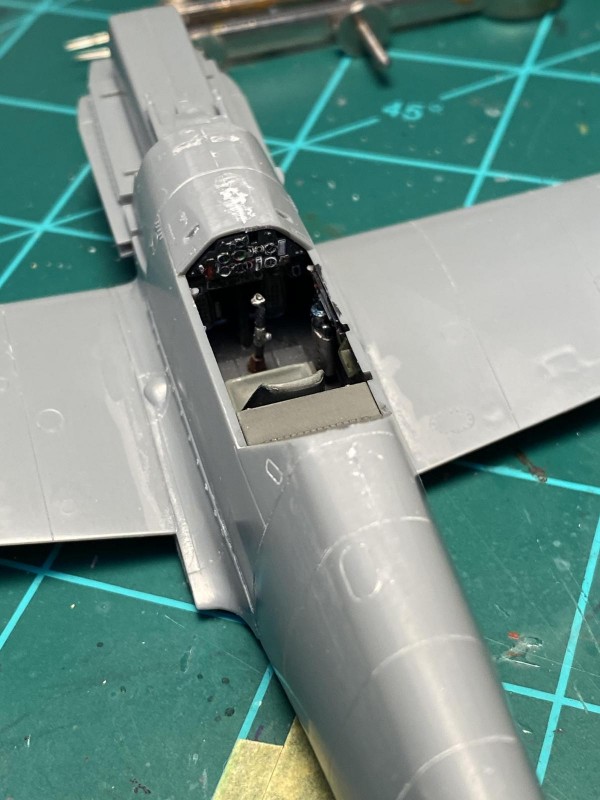
1. Kit decal over instrument panel
I was planning to use the pilot supplied in the kit so that I wouldn't have to come up with any seatbelts, but he really appeared sort of clunky when I got him done. This was still the plan until I sprayed some clear flat on the pilot. For some reason, all of the paints darkened considerably, making it look like our pilot had spent several days on the beach. I finally decided to delete the pilot and add some seat belts from the spares box.
-
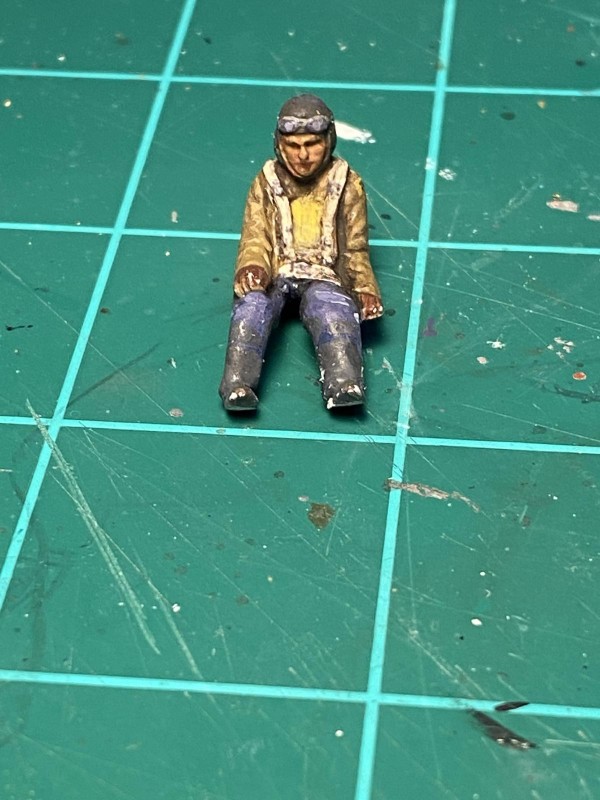
1. Our pilot looks a little clunky
The rest of the build to this point has been fairly uneventful. I did notice some sink marks that are visible in the area on the top of the wings over the flap area. This area would be really difficult to fill and sand, and then restore all the panel lines, so I took a vote an decided to continue the build and see if the depressions will be noticeable after painting. If they are, then I can decide if I am going to fix them.
-
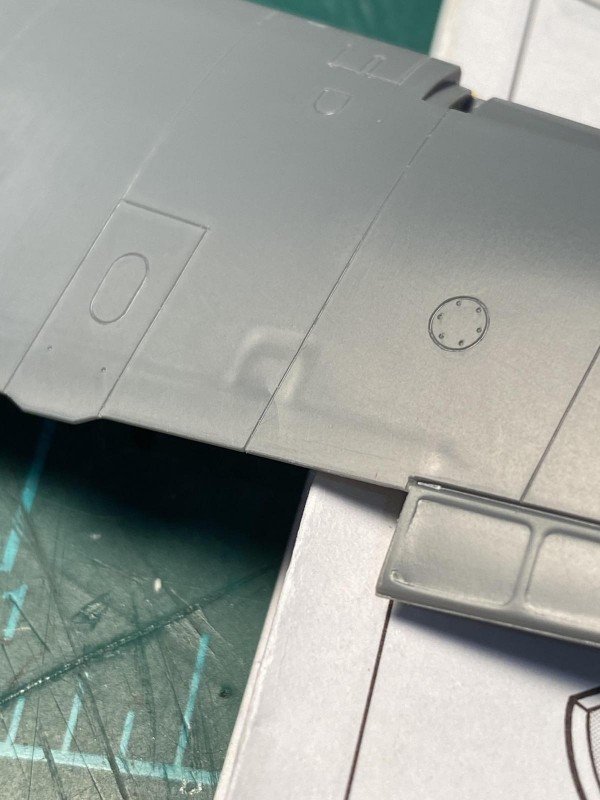
1. Sink marks in the flap area go all the way to the fuselage
I was ready to spray the white primer, and luckily I decided to check the decal instructions to be sure where the yellow stripes would be placed. There are decals for four different Romanian planes in this decal set, and two of them have stripes that are on different places on each wing, as well as having the wing roundels also placed asymmetrically. Luckily I had already decided on a plane that everything was in the same place on each side. There is a note that the old Luftwaffe camouflage was lightly visible under the green paint on the wings, as well as the German insignia that had been painted over. So, my painting plan is white primer first, followed by the yellow areas, then the simulated German camouflage, then the dark green overall in a thin coat, then some paint to simulate areas where the German insignia had been.